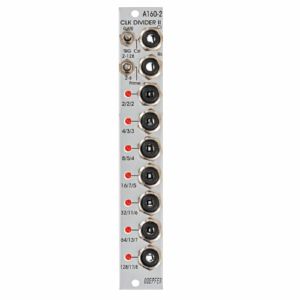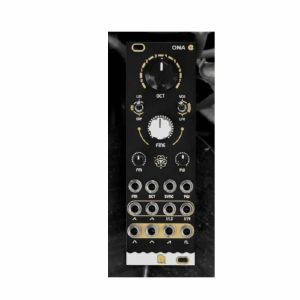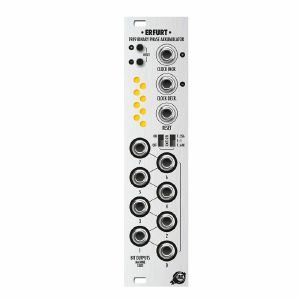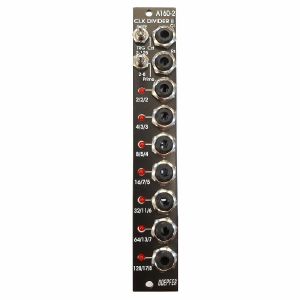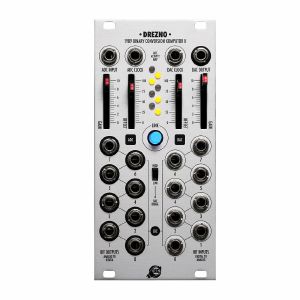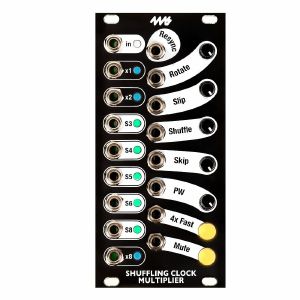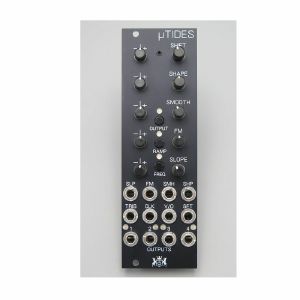Filter
Equipment
Format
Featured
Price
Tags
Tags: Frequency divider module
Products tagged as Frequency divider module
Items 1 to 7 of 7 on page 1 of 1
Doepfer A-160-2 Clock/Trigger Divider II Module (silver) (clock modulator/frequency divider synth module)
Cat: 671576 Rel: 29 Nov 17
Enhanced clock divider with multiple dividing factors - 4HP
Notes: Module A-160-2 is an enhanced version of the standard clock divider A-160. The module is a frequency divider for clock/trigger/gate signals, designed to be a source of lower frequencies, particularly for rhythm uses. The Clock input will take any digital signal from, eg. LFO, MIDI sync, or the gate from a MIDI-CV interface. At the outputs, you have access to three sets of seven different sub-divided clock signals, from half the clock frequency down to 1/128. The low/high levels of the output signals are 0V and about +10V.
The A-160-2 also has a reset input. Whenever a reset signal is sensed, all outputs are set to certain levels which depend upon the selected mode.
These are the most important features of the module:
Three different sets of dividing factors, selected by a three-position switch at the front panel:
- Power of two: 2, 4, 8, 16, 32, 64, 128
- Prime numbers: 2, 3, 5, 7, 11, 13, 17
- Integer: 2, 3, 4, 5, 6, 7, 8
Two output modes, selected by a two-position switch at the front panel:
- Gate mode: outputs act like the outputs of typical binary dividers
- Trigger mode: in this mode the outputs are AND-wired with the clock signal (i.e. the clock pulsewidth affects the pulsewidth of the outputs)
- Clock edge type selected by a jumper on the pc board:
- Positive: the rising edge of the clock signal triggers the state change of the outputs
- Negative: the falling edge of the clock signal triggers the state change of the outputs
Reset behaviour by two jumpers on the pc board:
- Level triggered: the level at the Reset input triggers the Reset
- Edge triggered: the edge of the signal at the Reset input triggers the Reset
- Positive: a high level (> 2.5V) or the rising edge at the Reset input triggers the Reset
- Negative: a low level (< 1 V) or the falling edge at the Reset input triggers the Reset
Output polarity selected by a jumper on the pc board:
- Positive: non-inverted outputs
- Negative: all seven outputs are inverted
Width: 4HP / 20mm
Depth: 35mm (Measured from the rear side of the front panel)
Current: +12V: +50mA, -12V: -0mA
… Read moreThe A-160-2 also has a reset input. Whenever a reset signal is sensed, all outputs are set to certain levels which depend upon the selected mode.
These are the most important features of the module:
Three different sets of dividing factors, selected by a three-position switch at the front panel:
- Power of two: 2, 4, 8, 16, 32, 64, 128
- Prime numbers: 2, 3, 5, 7, 11, 13, 17
- Integer: 2, 3, 4, 5, 6, 7, 8
Two output modes, selected by a two-position switch at the front panel:
- Gate mode: outputs act like the outputs of typical binary dividers
- Trigger mode: in this mode the outputs are AND-wired with the clock signal (i.e. the clock pulsewidth affects the pulsewidth of the outputs)
- Clock edge type selected by a jumper on the pc board:
- Positive: the rising edge of the clock signal triggers the state change of the outputs
- Negative: the falling edge of the clock signal triggers the state change of the outputs
Reset behaviour by two jumpers on the pc board:
- Level triggered: the level at the Reset input triggers the Reset
- Edge triggered: the edge of the signal at the Reset input triggers the Reset
- Positive: a high level (> 2.5V) or the rising edge at the Reset input triggers the Reset
- Negative: a low level (< 1 V) or the falling edge at the Reset input triggers the Reset
Output polarity selected by a jumper on the pc board:
- Positive: non-inverted outputs
- Negative: all seven outputs are inverted
Width: 4HP / 20mm
Depth: 35mm (Measured from the rear side of the front panel)
Current: +12V: +50mA, -12V: -0mA
2 in stock $103.92
Click for better price!
or call +44 20 7424 1960
quote 671576
quote 671576
NANO Modules ONA Analogue Multifunction Oscilator Module (oscillator synth module)
Cat: 796145 Rel: 20 Nov 20
clock generator / CV modulation / frequency divider / LFO / oscillator synth module
Notes: A warm and deep sound source you can rely on
A flexible and warm Analog Multifunction Oscillator, rich in harmonics. Excellent for performance use!
ONA can work as an Audio Oscillator or as a Low Frequency Modulator and it provides control over all its parameters, making it a versatile, deep and easy-to-use oscillator.
Thanks to its triangle-core oscillator and wave-shapers you can choose between a big palette of output waveforms to give shape to your ideas.
Classic Waveforms. Sine, Triangle, Saw and Square.
2 Complex Waveforms with Pulse Width Modulation.
2 Sub-Waveforms to add some bass sounds easily.
Blend them to give unlimited depth to your sound!
… Read moreA flexible and warm Analog Multifunction Oscillator, rich in harmonics. Excellent for performance use!
ONA can work as an Audio Oscillator or as a Low Frequency Modulator and it provides control over all its parameters, making it a versatile, deep and easy-to-use oscillator.
Thanks to its triangle-core oscillator and wave-shapers you can choose between a big palette of output waveforms to give shape to your ideas.
Classic Waveforms. Sine, Triangle, Saw and Square.
2 Complex Waveforms with Pulse Width Modulation.
2 Sub-Waveforms to add some bass sounds easily.
Blend them to give unlimited depth to your sound!
1 in stock $151.46
Xaoc Devices Erfurt 1989 Binary Phase Akkumulator Module (clock generator/frequency divider synth module)
Cat: 846596 Rel: 27 Apr 22
A digital module that may be used as an 8-output clock and audio frequency divider, a bi-directional binary counter, or a component of the Leibniz binary system.
Notes: Creatively inspiring business from Xaoc as usual. The Erfurt is a digital phase accumulator, digital oscillator, binary counter or clock/audio frequency divider. Versatile stuff.
Supplier's Notes:
Xaoc Devices Erfurt is a digital module that may be used as an 8-output clock and audio frequency divider, a bi-directional binary counter, or a component of the Leibniz binary system, i.e. a programmable digital oscillator.
Erfurt features an 8-bit register which holds its current state: an 8-bit number representing digital values from 0 to 255. The state is available at the front panel via eight binary (5V gate) outputs and reflected by the 8 status LEDs. There are three clock inputs: one incrementing the state at each impulse, one decrementing, and one resetting the state to zero. The state may also be changed manually with two buttons.
When operating alone, the state of Erfurt changes by 1 at each impulse from the clock inputs, so that it counts from 0 to 255 in a cycle (modulo 256). This yields the signal frequency divided by 2, 4, 8, etc. up to 128, available at individual bit outputs. Depending on which clock input is used, the clock patterns correspond to the so called mathematical or musical divisions of the rhythm.
With two different clocks patched to the inputs, the counter alternately increases and decreases its state, and ultimately it counts with a rate proportional to the frequency difference between the clocks. A third clock patched to the Reset input may be used to shorten the sequence thus making the cycle incomplete for even more rhythmic diversity.
When there is a Leibniz data source connected at the back (even as simple as Lipsk), the state increases or decreases in larger steps, depending on the data present at the Leibniz bus (eg. the value programmed by the Lipsk buttons). The counter overflows quicker, and produces more complex patterns.
The state of the counter may be used as a phase input to a digital wave table. Connected to other Leibniz modules, Erfurt may play various roles, eg. it may scan waveshapes in Jena, produce stepped voltages useful for making interesting glissandi with Drezno and any VCO, generate gate patterns animating the spectrum of Odessa harmonic banks, spawn pseudo-chaotic sequences when fed back to Lipsk, etc. Since Erfurt is based on CMOS logic (no CPU!), it can be clocked at very high frequencies (exceeding audio rate), therefore some selection switches are provided for clock pre-scaling.
Dimensions:
6 HP
Current Draw:
25 mA +12V
30 mA -12V
0 mA 5V
… Read moreSupplier's Notes:
Xaoc Devices Erfurt is a digital module that may be used as an 8-output clock and audio frequency divider, a bi-directional binary counter, or a component of the Leibniz binary system, i.e. a programmable digital oscillator.
Erfurt features an 8-bit register which holds its current state: an 8-bit number representing digital values from 0 to 255. The state is available at the front panel via eight binary (5V gate) outputs and reflected by the 8 status LEDs. There are three clock inputs: one incrementing the state at each impulse, one decrementing, and one resetting the state to zero. The state may also be changed manually with two buttons.
When operating alone, the state of Erfurt changes by 1 at each impulse from the clock inputs, so that it counts from 0 to 255 in a cycle (modulo 256). This yields the signal frequency divided by 2, 4, 8, etc. up to 128, available at individual bit outputs. Depending on which clock input is used, the clock patterns correspond to the so called mathematical or musical divisions of the rhythm.
With two different clocks patched to the inputs, the counter alternately increases and decreases its state, and ultimately it counts with a rate proportional to the frequency difference between the clocks. A third clock patched to the Reset input may be used to shorten the sequence thus making the cycle incomplete for even more rhythmic diversity.
When there is a Leibniz data source connected at the back (even as simple as Lipsk), the state increases or decreases in larger steps, depending on the data present at the Leibniz bus (eg. the value programmed by the Lipsk buttons). The counter overflows quicker, and produces more complex patterns.
The state of the counter may be used as a phase input to a digital wave table. Connected to other Leibniz modules, Erfurt may play various roles, eg. it may scan waveshapes in Jena, produce stepped voltages useful for making interesting glissandi with Drezno and any VCO, generate gate patterns animating the spectrum of Odessa harmonic banks, spawn pseudo-chaotic sequences when fed back to Lipsk, etc. Since Erfurt is based on CMOS logic (no CPU!), it can be clocked at very high frequencies (exceeding audio rate), therefore some selection switches are provided for clock pre-scaling.
Dimensions:
6 HP
Current Draw:
25 mA +12V
30 mA -12V
0 mA 5V
2 in stock $138.19
Doepfer A-160-2v Clock/Trigger Divider II Module (vintage edition) (clock modulator synth module)
Cat: 864696 Rel: 14 Mar 22
Module A-160-2 is an enhanced version of the standard clock divider A-160.
Notes: Module A-160-2V is an enhanced version of the standard clock divider A-160. The module is a frequency divider for clock/trigger/gate signals, designed to be a source of lower frequencies, particularly for rhythm uses.
The Clock input will take any digital signal from, eg., an LFO, MIDI sync, or the gate from a MIDI-CV interface. At the outputs, you have access to three sets of seven different sub-divided clock signals, from half the clock frequency down to 1/128. The low/high levels of the output signals are 0V and about +10V.
The A-160-2V also has a reset input. Whenever a reset signal is sensed, all outputs are set to certain levels which depend upon the selected mode.
HP : 4
… Read moreThe Clock input will take any digital signal from, eg., an LFO, MIDI sync, or the gate from a MIDI-CV interface. At the outputs, you have access to three sets of seven different sub-divided clock signals, from half the clock frequency down to 1/128. The low/high levels of the output signals are 0V and about +10V.
The A-160-2V also has a reset input. Whenever a reset signal is sensed, all outputs are set to certain levels which depend upon the selected mode.
HP : 4
3 in stock $114.97
Click for better price!
or call +44 20 7424 1960
quote 864696
quote 864696
Xaoc Devices Drezno II 1989 Binary Conversion Komputor Module (comparator/CV modulation/distortion/frequency divider/logic/quantizer/sample & hold/waveshaper synth module)
Cat: 945630 Rel: 10 Nov 23
An improved version of the original Drezno module in 12HP.
Notes: Part of Xaoc's Leibniz Binary Subsystem, the updated Drezno ADC/DAC module builds on the original with higher resolution converters, allowing you to use it for pitch quantisation.
Supplier's Notes:
Drezno II is an improved version of the original Drezno module. It is an essential member of the 8-bit Xaoc Devices Leibniz Binary Subsystem. The Leibniz subsystem is a family of modules that operate on 8 binary (two-state, on/off) signals. These signals are arranged as 8 bits of digital data and may represent analogue signals and voltages, or they may be whatever you want them to be (clocks, gates, rhythms, etc.).
Drezno features an ADC (analogue-to-digital-converter) and DAC (digital-to-analogue-converter), allowing it to act as an analog front-end of the system. In other words, Drezno allows one to convert analogue signals and CVs into digital numbers, as well as to obtain analogue signals back from some other digital numbers (or 8 binary signals). Between these two conversions there is a whole universe of digital shenanigans waiting to happen resulting in all kinds of signal transformations and modulations.
Both (ADC and DAC) sections of Drezno can work independently, or they can be linked. Input and output range of analogue signals may be adjusted using Gain and Offset sliders. Individual bit outputs (for the ADC) and inputs (DAC) allow for extensive cross-patching and the creation of complex waveforms and rhythms. A very fast clock (up to 2MHz) at which the conversions are performed may be replaced with any external clock (for each section separately).
Compared to its predecessor, Drezno II uses new converters of much higher resolution which results in much lower noise floor and higher accuracy. The lower bits are much more stable than before. It is easy now to use Drezno for quantizing pitch voltages with accurate results with 128 or 256 semitone steps. Potentiometer ranges are factory calibrated for precise chromatic scale. A new switch on the front panel allows the user to select the calibrated range of 10Vpp or 20Vpp, so that the lowest bit or the second bit correspond to 1 semitone.
Technical details
Eurorack synth compatible
12hp, skiff friendly
Current draw: +80mA/-50mA
Reverse power protection
… Read moreSupplier's Notes:
Drezno II is an improved version of the original Drezno module. It is an essential member of the 8-bit Xaoc Devices Leibniz Binary Subsystem. The Leibniz subsystem is a family of modules that operate on 8 binary (two-state, on/off) signals. These signals are arranged as 8 bits of digital data and may represent analogue signals and voltages, or they may be whatever you want them to be (clocks, gates, rhythms, etc.).
Drezno features an ADC (analogue-to-digital-converter) and DAC (digital-to-analogue-converter), allowing it to act as an analog front-end of the system. In other words, Drezno allows one to convert analogue signals and CVs into digital numbers, as well as to obtain analogue signals back from some other digital numbers (or 8 binary signals). Between these two conversions there is a whole universe of digital shenanigans waiting to happen resulting in all kinds of signal transformations and modulations.
Both (ADC and DAC) sections of Drezno can work independently, or they can be linked. Input and output range of analogue signals may be adjusted using Gain and Offset sliders. Individual bit outputs (for the ADC) and inputs (DAC) allow for extensive cross-patching and the creation of complex waveforms and rhythms. A very fast clock (up to 2MHz) at which the conversions are performed may be replaced with any external clock (for each section separately).
Compared to its predecessor, Drezno II uses new converters of much higher resolution which results in much lower noise floor and higher accuracy. The lower bits are much more stable than before. It is easy now to use Drezno for quantizing pitch voltages with accurate results with 128 or 256 semitone steps. Potentiometer ranges are factory calibrated for precise chromatic scale. A new switch on the front panel allows the user to select the calibrated range of 10Vpp or 20Vpp, so that the lowest bit or the second bit correspond to 1 semitone.
Technical details
Eurorack synth compatible
12hp, skiff friendly
Current draw: +80mA/-50mA
Reverse power protection
1 in stock $263.12
4ms SCM Plus Shuffling Clock Multiplier Module (clock generator/clock modulator/frequency divider synth module)
Cat: 901317 Rel: 29 Sep 22
The SCM Plus is a clock multiplier with eight gate outputs and complex beat manipulation features.
Notes: The SCM Plus is a clock multiplier with eight gate outputs and complex beat manipulation features. It combines the classic Shuffling Clock Multiplier (SCM) and SCM Breakout (SCMBO) into a single module using higher precision hardware than its predecessors.
Specs:
Electrical and Mechanical Specifications
12HP Eurorack format module
0.95" (24mm) maximum depth (includes power cable)
16-pin Eurorack power header
Power consumption
+12V: 52mA max
-12V: 15mA
Clock Input
2.5V threshold
40kHz maximum
Clock Outputs
12V gate outputs, rise/fall time approximately 1us
40kHz maximum
Jitter (x1 output): max 30us < 120BPM, max 5us >= 120BPM
Latency (clock in to x1 output): 8us worst-case, 3.5us typical
CV Inputs:
Rotate, Slip: Knob attenuates jack signal. Full range: 0V to +3.3V
Shuffle, Skip, PW: Knob offsets jack signal. Full range: -5V to +5V
Gate Inputs:
4x Fast, Mute: 2.5V threshold. Button toggles state.
… Read moreSpecs:
Electrical and Mechanical Specifications
12HP Eurorack format module
0.95" (24mm) maximum depth (includes power cable)
16-pin Eurorack power header
Power consumption
+12V: 52mA max
-12V: 15mA
Clock Input
2.5V threshold
40kHz maximum
Clock Outputs
12V gate outputs, rise/fall time approximately 1us
40kHz maximum
Jitter (x1 output): max 30us < 120BPM, max 5us >= 120BPM
Latency (clock in to x1 output): 8us worst-case, 3.5us typical
CV Inputs:
Rotate, Slip: Knob attenuates jack signal. Full range: 0V to +3.3V
Shuffle, Skip, PW: Knob offsets jack signal. Full range: -5V to +5V
Gate Inputs:
4x Fast, Mute: 2.5V threshold. Button toggles state.
2 in stock $181.31
Click for better price!
or call +44 20 7424 1960
quote 901317
quote 901317
Michigan Synth Works MicroTides Version 2 Tidal modulator Module (black) (clock generator/digital/envelope generator/frequency divider/function generator/LFO/oscillator synth module)
Cat: 802220 Rel: 07 Jan 21
Micro tidal modulator module in 8HP.
Notes: 8HP Tides version 2
Fully calibrated.
… Read moreFully calibrated.
2 in stock $184.62
Click for better price!
or call +44 20 7424 1960
quote 802220
quote 802220
Items 1 to 7 of 7 on page 1 of 1

 USD
USD





